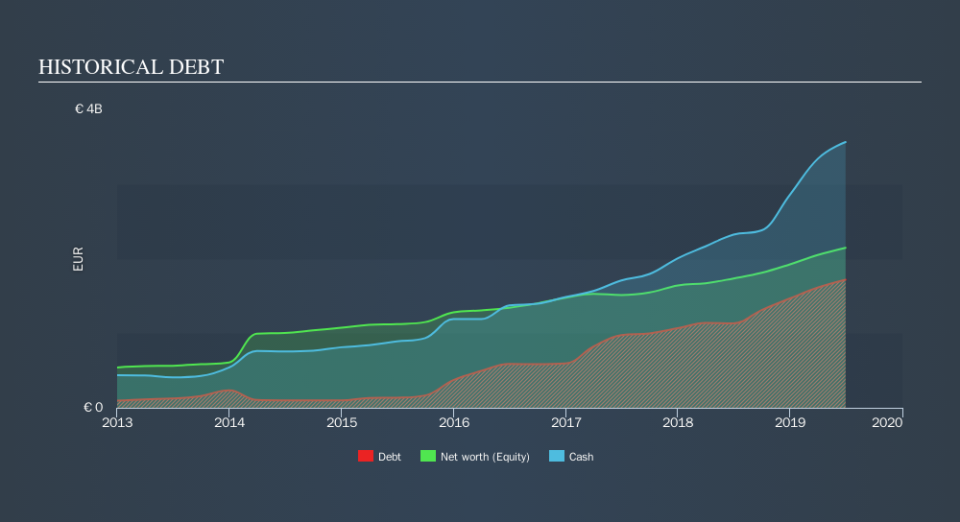Wirecard (ETR:WDI) Seems To Use Debt Rather Sparingly

Legendary fund manager Li Lu (who Charlie Munger backed) once said, 'The biggest investment risk is not the volatility of prices, but whether you will suffer a permanent loss of capital. So it seems the smart money knows that debt - which is usually involved in bankruptcies - is a very important factor, when you assess how risky a company is. We can see that Wirecard AG (ETR:WDI) does use debt in its business. But should shareholders be worried about its use of debt?
When Is Debt Dangerous?
Debt and other liabilities become risky for a business when it cannot easily fulfill those obligations, either with free cash flow or by raising capital at an attractive price. In the worst case scenario, a company can go bankrupt if it cannot pay its creditors. However, a more usual (but still expensive) situation is where a company must dilute shareholders at a cheap share price simply to get debt under control. Of course, debt can be an important tool in businesses, particularly capital heavy businesses. When we examine debt levels, we first consider both cash and debt levels, together.
See our latest analysis for Wirecard
What Is Wirecard's Debt?
The image below, which you can click on for greater detail, shows that at June 2019 Wirecard had debt of €1.72b, up from €1.16b in one year. But on the other hand it also has €3.56b in cash, leading to a €1.84b net cash position.
How Healthy Is Wirecard's Balance Sheet?
We can see from the most recent balance sheet that Wirecard had liabilities of €2.72b falling due within a year, and liabilities of €1.83b due beyond that. Offsetting these obligations, it had cash of €3.56b as well as receivables valued at €1.20b due within 12 months. So it can boast €213.3m more liquid assets than total liabilities.
Having regard to Wirecard's size, it seems that its liquid assets are well balanced with its total liabilities. So it's very unlikely that the €14.7b company is short on cash, but still worth keeping an eye on the balance sheet. Succinctly put, Wirecard boasts net cash, so it's fair to say it does not have a heavy debt load!
In addition to that, we're happy to report that Wirecard has boosted its EBIT by 44%, thus reducing the spectre of future debt repayments. There's no doubt that we learn most about debt from the balance sheet. But it is future earnings, more than anything, that will determine Wirecard's ability to maintain a healthy balance sheet going forward. So if you want to see what the professionals think, you might find this free report on analyst profit forecasts to be interesting.
Finally, a business needs free cash flow to pay off debt; accounting profits just don't cut it. Wirecard may have net cash on the balance sheet, but it is still interesting to look at how well the business converts its earnings before interest and tax (EBIT) to free cash flow, because that will influence both its need for, and its capacity to manage debt. Over the last three years, Wirecard actually produced more free cash flow than EBIT. That sort of strong cash generation warms our hearts like a puppy in a bumblebee suit.
Summing up
While it is always sensible to investigate a company's debt, in this case Wirecard has €1.84b in net cash and a decent-looking balance sheet. The cherry on top was that in converted 112% of that EBIT to free cash flow, bringing in €615m. So we don't think Wirecard's use of debt is risky. Above most other metrics, we think its important to track how fast earnings per share is growing, if at all. If you've also come to that realization, you're in luck, because today you can view this interactive graph of Wirecard's earnings per share history for free.
When all is said and done, sometimes its easier to focus on companies that don't even need debt. Readers can access a list of growth stocks with zero net debt 100% free, right now.
We aim to bring you long-term focused research analysis driven by fundamental data. Note that our analysis may not factor in the latest price-sensitive company announcements or qualitative material.
If you spot an error that warrants correction, please contact the editor at editorial-team@simplywallst.com. This article by Simply Wall St is general in nature. It does not constitute a recommendation to buy or sell any stock, and does not take account of your objectives, or your financial situation. Simply Wall St has no position in the stocks mentioned. Thank you for reading.

 Yahoo Finance
Yahoo Finance 
